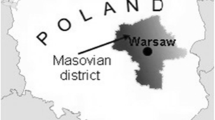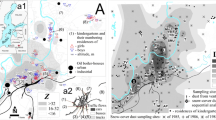Summary
The influence of several factors on cadmium (Cd) concentrations in the hair of 474 pre-school children was examined. The study was performed in an industrial (Duisburg) and rural area (Westfalen) of the (FRG). Season, sex, hair color, and place of residence were found to be the main factors influencing Cd levels in hair. Concentrations of Cd in samples obtained during summer were on the average nearly twice as high as those sampled during winter (geometric means: 116.1 vs. 63.7ng/g). Boys had more Cd in their hair than girls (111.5 vs.74.0 ng/g). Cd levels in hair decreased from red to blond, to brown, and black hair. Children living in Duisburg had more Cd in their hair than those from rural areas (103.9 vs.77.Ong/g). Cd content in hair was inversely related to age.
Similar content being viewed by others
References
Anke M, Grün M, Kronemann H, Schneider HJ (1980) Die Diagnose der Kadmiumbelastung beim Menschen. Wiss Z Karl-Marx-Univ 29:515–522
Aurand K, Sonneborn M (1974) Metallgehalt in menschlichen Haaren und Zähnen verschiedener Bevölkerungsgruppen als Screening-Verfahren zur Überwachung der Cadmium-Belastung. In: Commission of European Community (ed) Contamination of man and his environment by mercury and cadmium. Luxembourg
Aurand K, Hoffmeister H (1980) Ad hoc-Felduntersuchungen über die Schwermetallbelastung der Bevölkerung im Raum Oker im März 1980. Schriftenreihe des Bundesgesundheitsamtes 2/1980. D Reimer Verlag, Berlin
Baker EL, Hayes CG, Landrigan PJ, Handke JL, Leger RT, Housworth WJ, Harrington JM (1977) A nationwide survey of heavy metal absorption in children living near primary copper, lead, and zinc smelters. Am J Epidemiol 106:261–273
Barlow PJ (1983) A pilot study on the metal levels in the hair of hyperactive children. Med Hypotheses 11:309–318
Barlow PJ, Francois PE, Goldberg IJL, Richardson I, Izmeth MGA, Kumpeson K, Sykes P (1986) Trace metal abnormalities in longstay hyperactive mentally handicapped children and agitated senile dementia. J R Soc Med 79:581–583
Bhat KR, Arunachalam J, Yegnasubramanian S (1982) Trace elements in hair and environmental exposure. Sci Total Environ 22:169–178
Boiteau HL, Stoklov M, Remond D, Buffet H, Metayer C, Vincent F, Corneteau H, Faure J (1983) Taux de plomb, de cadmium des habitants des regions de Nantes et de Grenoble. Toxicol Eur Res 6:281–291
Capel ID, Pinnock MH, Dorrell HM, Williams DC, Grant ECG (1981) Comparison of concentrations of some trace, bulk and toxic metals in the hair of normal and dyslexic children. Clin Chem 27:879–881
Creason JP, Hinners TA, Bumgarner JE, Pinkerton C (1975) Trace elements in hair as related to exposure in metropolitan New York. Clin Chem 21:603–612
Dorn CR, Phillips PE, Pierce II JO, Chase GR (1974) Cadmium, copper, lead and zinc in bovine hair in the New Lead Belt of Missouri. Bull Environ Contam Toxicol 12:262–632
Drasch G (1983) An increase of cadmium body burden for this century — an investigation on human tissues. Sci Total Environ 26:111–119
Drasch G, Kauert G, von Meyer L (1985) Cadmium body burden of an occupationally non burdened population in southern Bavaria. Int Arch Occup Environ Health 55:141–148
Ellis KJ, Yasumura S, Cohn SH (1981) Hair cadmium content: is it a biological indicator of the body burden of cadmium for the occupationally exposed worker? Am J Ind Med 2:323–330
Ely DL, Mostardi RA, Woebkenberg N, Worstell D (1981) Aerometric and hair trace element content in learning-disabled children. Environ Res 25:325–339
Ewers U, Brockhaus A, Winneke G, Freier I, Jermann E, Krämer U (1982) Lead in deciduous teeth of children living in a non-ferrous smelter area of the FRG. Int Arch Occup Environ Health 50:139–151
Ewers U, Dolgner R, Brockhaus A, Freier I, Jermann E, Hilser W, Domisch K, Braun R (1984) Untersuchungen zur Blei- und Cadmiumbelastung von Kindern und Jugendlichen in einem schwermetallbelastetem Gebiet (Stolberg). Off Gesundh Wes 46:231–236
Ewers U, Brockhaus A, Freier I, Jermann E, Dolgner R (1985) Contribution of lead and cadmium in dustfall to blood lead and blood cadmium in children and adults living in two non-ferrous smelter areas of West-Germany. In: Lekkas TD (ed) Proceedings of the Vth International Conference ‘Heavy Metals in the Environment’. CEP Consultants Ltd, Edinburgh, vol I, pp 420–422
Gordon GF (1985) Sex and age related differences in trace element concentrations in hair. Sci Total Environ 42:133–147
Gross SB, Yeager DW, Middendorf MS (1976) Cadmium in liver, kidney, and hair of humans, fetal through old age. J Toxicol Environ Health 2:153–167
Hahn R, Ewers U, Jermann E, Freier I, Brockhaus A, Schlipköter HW (1987) Cadmium in kidney cortex of inhabitants of North-West Germany: its relationship to age, sex, smoking and environmental pollution by cadmium. Int Arch Occup Environ Health 59:165–176
Hambidge KM, Walravens PA, Kumar V, Tuchinda C (1974) Chromium, zinc, manganese, copper, nickel, iron and cadmium concentrations in the hair of residents of Chandigarh, India and Bangkok, Thailand. In: Hemphill DD (ed) Trace substance in environmental health VIII. University of Missouri, Columbia, pp 39–44
Hammer DI, Finklea JF, Hendricks RH, Shy CM, Horton RJM (1971) Hair trace metal levels and environmental exposure. Am J Epidemiol 93:84–92
Herber RFM, Wibowo AAE, Das HA, Egger RJ, van Deyck W, Zielhuis RL (1983) Trace element levels in hair of eight-year-old children. Int Arch Occup Environ Health 53:127–137
Huel G, Ibrahim MA, Boudene C (1981) Cadmium and lead content of maternal and newborn hair: relationship to parity, birth weight, and hypertension. Arch Environ Health 36:221–227
Huel G, Everson RB, Menger I (1984) Increased hair cadmium in newborns of women occupationally exposed to heavy metals. Environ Res 35:115–121
Jervis RE (1967) Applications of activation analysis in forensic science. IAEA, Amsterdam
Kimbrough RD, Falk H, Stehr P, Fries G (1984) Health implications of 2.3.7.8-tetrachloro-dibenzodioxin (TCDD) contamination of residential soil. J Toxicol Environ Health 14:47–93
Kjellström T (1979) Exposure and accumulation of cadmium in populations from Japan, the United States, and Sweden. Environ Health Perspect 28:169–197
Kollmer WE (1982) The significance of Cd in hair. Influence of the level of intake and the external contamination in the rat. Sci Total Environ 25:41–45
Kowal NE, Johnson DE, Kraemer DF, Pahren HR (1979) Normal levels of cadmium in diet, urine, blood, and tissues of inhabitants of the United States. J Toxicol Environ Health 5:995–1014
Laker M (1982) On determining trace element levels in man: the uses of blood and hair. Lancet 2:260–262
Landesanstalt für Immissionsschutz des Landes Nordrhein-Westfalen (1985) Schriftenreihe 63. Verlag W Girardet, Essen
Lauwerys R, Hardy R, Job M, Buchet JP, Roels H, Bruaux P, Rondia D (1984) Environmental pollution by cadmium and cadmium body burden: an autopsy study. Toxicol Lett 23:287–289
Matsubara J, Machida K (1985) Significance of elemental analysis of hair as a means of detecting environmental pollution. Environ Res 38:225–238
Milosevic M, Petrovic L, Petrovic D, Pejuskovic B (1980) Epidemiological significance of determination of lead, cadmium, copper and zinc in hair and permanent teeth, in persons living in the vicinity of a lead smeltery. Arh Hig Rada Toksikol 31:209–217
Morton DE, Saah AJ, Silberg SL, Owens WL, Roberts MA, Saah MD (1982) Lead absorption in children of employes in a lead-related industry. Am J Epidemiol 115:549–555
Nordberg GF, Nishiyama K (1972) Whole body and hair retention of cadmium in mice. Arch Environ Health 24:209–214
Ohnesorge FK (1985a) Die Bewertung der Schwermetallbelastung im Kindesalter. In: Gladke E, Heimann G, Lombeck L, Eckert I (eds) Spurenelemente. Thieme Verlag, Stuttgart New York, pp 135–143
Ohnesorge FK (1985b) Toxikologische Bewertung von Arsen, Blei, Cadmium, Nickel, Thallium und Zink. Fortschritte VDI. Reihe 15:38
Okamoto K, Morita M, Quan H, Uehiro T, Fuwa K (1985) Preparation and certification of human hair powder reference material. Clin Chem 31:1592–1597
Oleru UG (1975) Epidemiological implications of environmental cadmium. Am Ind Hyg Assoc J 36:229–233
Petering HG, Yeager DW, Witherup SO (1973) Trace metal content of hair. Arch Environ Health 27:327–330
Pihl RO, Parkes M (1977) Hair element content in learning disabled children. Science 198:204–206
Rosmanith J, Einbrodt HJ, Gordon T (1975) Relationship between immission of plump and zinc and the levels of plumb, zinc, and cadmium in blood, urine, and hair in children. Zbl Bakt Hyg [I Abt Orig B] 161:125–136
Rosmanith J, Einbrodt HJ, Ehm W (1977) To the behaviour of cadmium and lead in children with a different cadmium or lead burden. Zbl Bakt Hyg [I Abt Orig B] 165:207–225
Schaller KH, Schroeder L, Hall G, Valentin H (1984) Cadmium-Gehalt im Vollblut bei Bewohnern verschiedener Regionen des Freistaates Bayern. Zbl Bakt Hyg [I Abt Orig B] 178:446–463
Schroeder HA, Nason AP (1969) Trace elements in human hair. J Invest Dermatol 53:71–78
Shaikh ZA, Smith LM (1984) Biological indicators of cadmium exposure and toxicity. Experientia 40:36–43
Stadt Duisburg (1982) Auswirkungen von Blei und Cadmium aus Staubniederschlägen auf Böden und Pflanzen. Untersuchungen des Chemischen und Lebensmitteluntersuchungsamtes der Stadt Duisburg. Manuskript im Selbstverlag
Stadt Duisburg (1985) Blei and Cadmium in Duisburg. Studie aus dem Chemischen and Lebensmitteluntersuchungsamtes der Stadt Duisburg. Manuskript im Selbstverlag
Tomza U, Janicki T, Kosman J (1983) Instrumental neutron activation of trace element in hair: a study of occupational exposure to a non-ferrous smelter. In: Anke M, Baumann W, Bräunlich H, Brückner C (eds) 4. Spurenelement-Symposium. Karl-Marx-Univ, Leipzig, Friedrich-Schaller-Universität, Jena, pp 362–368
Wecker L, Miller SB, Cochran SR, Dugger DL, Johnson WD (1985) Trace element concentrations in hair from autistic children. J Ment Defic Res 29:15–22
Wibowo AAE, Herber FRM, Das HA, Roeleveld N, Zielhuis RL (1986) Levels of metals in hair of young children as an indicator of environmental pollution. Environ Res 40:346–356
Author information
Authors and Affiliations
Rights and permissions
About this article
Cite this article
Wilhelm, M., Hafner, D., Lombeck, I. et al. Variables influencing cadmium concentrations in hair of pre-school children living in different areas of the Federal Republic of Germany. Int. Arch Occup Environ Heath 60, 43–50 (1988). https://doi.org/10.1007/BF00409378
Received:
Accepted:
Issue Date:
DOI: https://doi.org/10.1007/BF00409378




